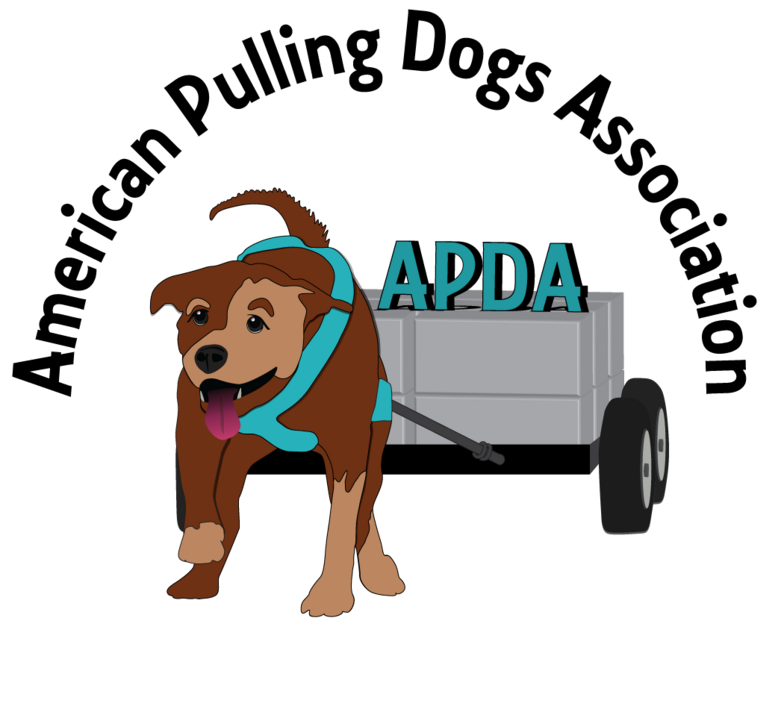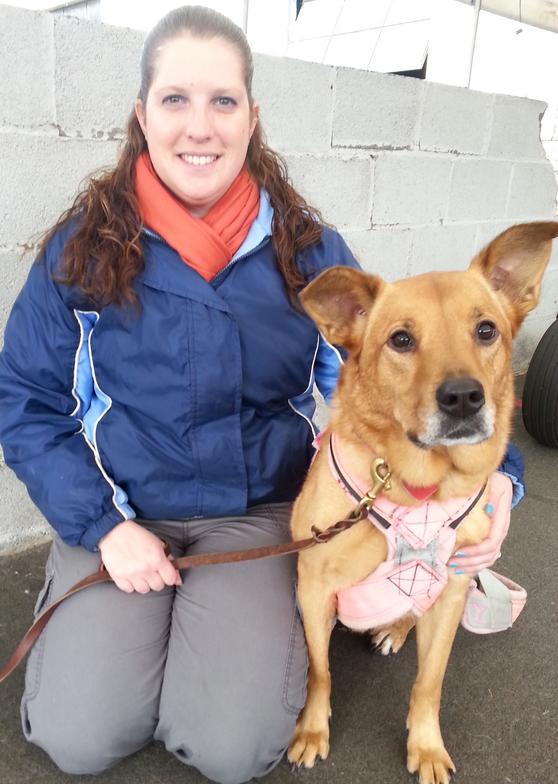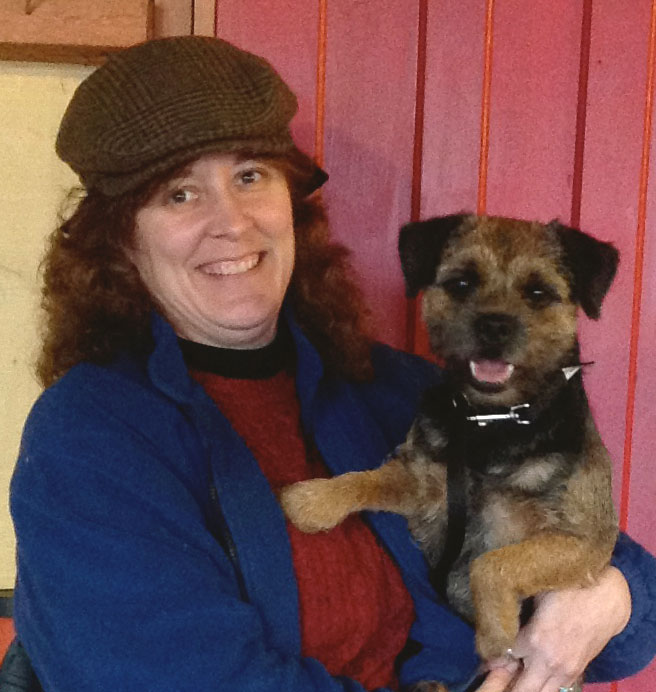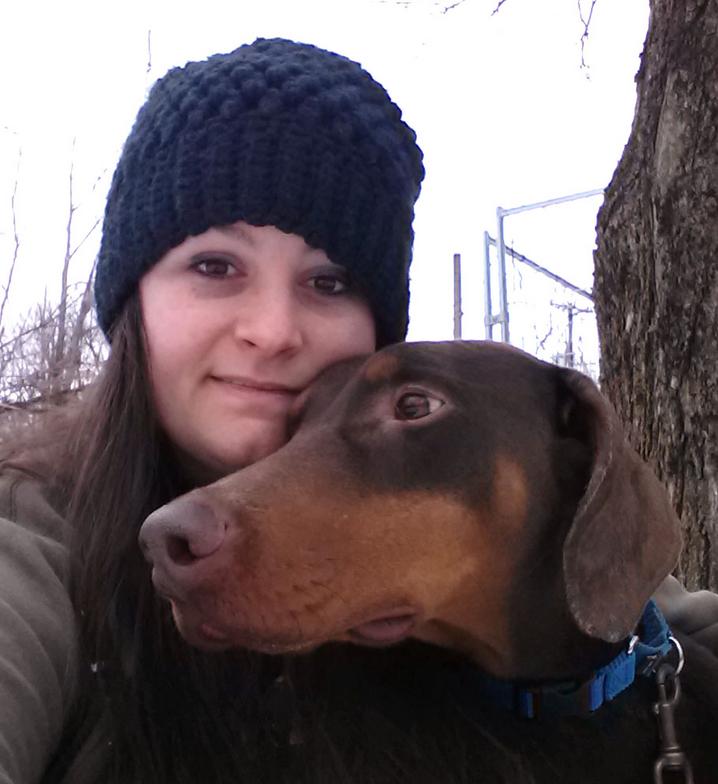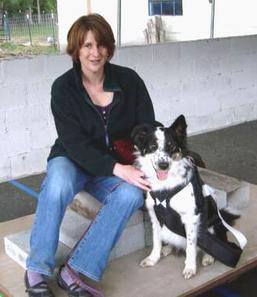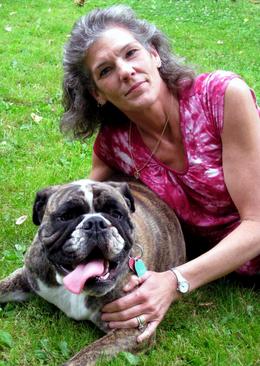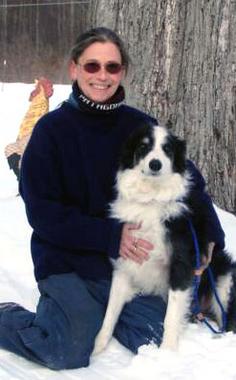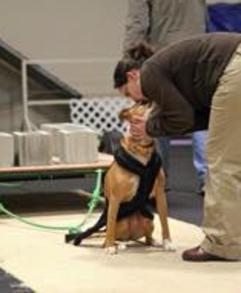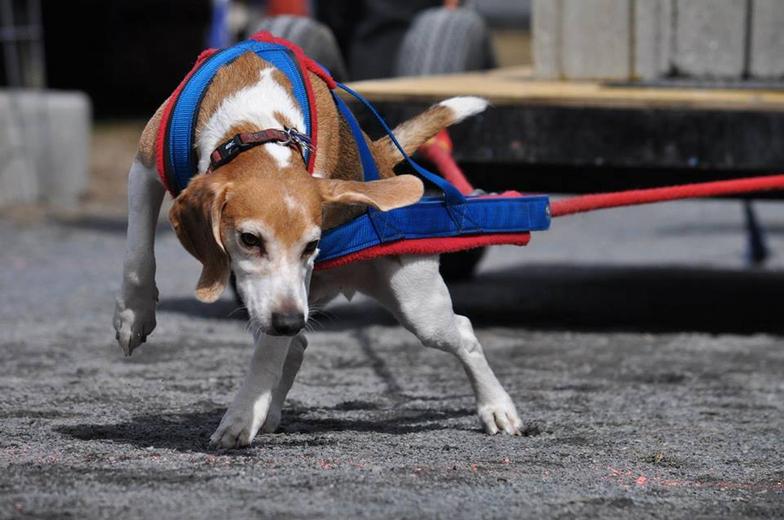American Pulling Dogs Association
Weightpulling as Behavioral Therapy
Frequently, dog owners contact veterinarians, behaviorists and trainers with complaints about behavior problems with their dogs. These behaviors may be repetitive or obsessive in nature like self mutilation, spinning, pacing or light gazing, or can be social in nature like excessive shyness, reactivity or aggression. Some owners might even describe their pets as hyperactive or attention deficit in the way we might classify people as ADD or ADHD. Some people even hope medications could be an answer.
Although it is difficult to diagnose or compare the dog's mind or behavior to humans, some of the things we see ARE similar in nature and DO respond to many of the same treatments.
As trainers, veterinarians and behaviorists have found, many dogs' behavioral issues benefit from various types of activity and exercise training, such as Agility and Obedience training. As many people who work with children who suffer from Autism, ADD and ADHD have found, swimming and resistance training also have significant additional benefits. Likewise, many people have found similar significant improvements with this type of exercise training for their dogs.
Geraldine Dawson, Chief Science Officer at Autism Speaks, wrote a paper entitled “Sports, Exercise, and the Benefits of Physical Activity for Individuals with Autism” in which she notes that the incidence of obesity in children with ASD (autistism spectrum disorder) is higher than for neurotypical children. In addition, she points to findings that indicate that exercise provide behavioral as well as health benefits:
Research has also demonstrated that increased aerobic exercise can significantly decrease the frequency of negative, self-stimulating behaviors that are common among individuals with autism, while not decreasing other positive behaviors. … Behaviors such as body rocking, spinning, head-nodding, hand flapping, object-tapping, and light gazing, that have been shown to interfere with positive social behavior and learning, can thus be controlled by the use of exercise. Additionally, exercise can discourage aggressive and self-injurious behavior while improving attention span. … One theory behind these findings is that the highly structured routines, or repetitive behaviors involved in running or swimming, may be similar to and/or distract from those self-stimulating, repetitive behaviors associated with autism.
In the light of the changes over the last 40 years in our lifestyle, culture, personal activity levels and the lack of time available in working households, we see more and more dogs who have an exercise requirement that is difficult for some owners to fulfill, which can lead to various issues. Dog professionals in some areas have found a different type of exercise, specifically weightpulling, to be not only easier for many clients to provide, without a high investment of time, money and equipment, but have also shown significant improvements in various behavior problems as well.
As a result, some dogs who might have otherwise wound up in a shelter or re-homed, who would likely have been doomed because their needs and problems have not been addressed, can have a second chance. Now owners have a way to fulfill their dog's energy requirements that is not time consuming, yet is still fun and even helpful to their owners.
Testimonials.
Below are testimonials of various dogs and their owners who have experienced success addressing a variety of behavioral problems through the use of weightpulling as part of their behavioral rehabilitation. It is an excellent resource for draining energy, as well as a good way of building confidence.
These are all real dogs and their owners who found success with various breeds and behavioral problems using a combination or behavioral modification, training and resistance training in the form of weightpulling.
Heather Horton and Dory (Cattledog mixed breed)
Before we started participating in weightpull, Dory had behavioral problems. She was always on alert, very reactive and showed fear aggression. If she was uncomfortable with a situation, she felt the need to control it, so she would charge and/or nip at it. Bicycles, someone running, anything that “threatened” her. She was a very anxious and fearful dog. Weightpull has benefited Dory immensely. It drained her excess energy very quickly, leaving her calmer, and apparently, much less stressed. With a combination of weightpull and other training for behavioral modifications, Dory is now a happy dog, who is not worried or fearful in situations that used to make her very anxious and reactive, showing fear aggression. Instead of trying to control the situation by charging and nipping, she practices avoidance behaviors, and looks to me as her leader to handle the situation.
Lisa Mawson, owner and trainer at Canine Culture (Border Terrier)
Wyatt was adopted by me at 6 months of age, after previously being in a loving home who experienced an inability to cope with what might be described as a hyper-active energy level. His excess energy caused him to be extremely reactive to many situations in which he exhibited uncontrollable excitement in the form of aggression. His breeder wisely decided this was not a good situation for him, or his previous owner, and looked for a home that could provide him with the right guidance and an appropriate energy outlet. A job. Now with the right leadership, behavioral modification, and a new way to drain his excess energy in a calm, thinking way, he now is a much more balanced, sweet, intelligent companion with hardly any evidence of his misspent youth.
Laura Yaghy, CPDT-KA and Havoc (Doberman)
When Havoc first came to me he was extremely nervous, under-socialized,
emaciated, and at 3 years old, had 3 previous homes that were unable to help him.
Too much energy was one of the many complaints about him, and is likely why he
was named Havoc in the first place. Having apparently not had any structure, or
consistency in his life, I started obedience training him, which was difficult at first,
since he had never learned focus or problem solving. As soon as I started weight
dragging with him during walks, it all started coming together. Weightpulling
helped him learn to focus on the task at hand, since before weightpull training, if
something we were working on for obedience was too confusing he would
immediately shut down rather than try to work out the problem. Since weightpull
was an easy task to figure out, and came quite naturally to him, it gave him some
confidence and helped his ability to focus and problem solve. He is very good at
that now, and isn't afraid to offer new behaviors anymore. He never shuts down in
obedience training anymore either.
From a physical perspective weightpull definitely helped him get back into shape after being so emaciated and having so little muscle tone. It also is the easiest way to drain his excess energy. Weightpull also helped him with socialization. It allows us to get out and be around people and dogs, in a controlled setting, while he had something else to think about, so that it wasn't too overwhelming for him. The thing that we love the most about weightpull is that it really helped Havoc and I bond with each other. He was very afraid of me at first and would tolerate human interaction but never initiated it, or really enjoy it. Now he seeks attention and is very happy overall. The day he started wriggling his tail (something that never happened in the beginning) I knew he was finally opening up. As a professional dog trainer I feel weightpulling is an excellent way to bond with your dog, and also exercise them. It has helped my dogs and I become a team and has really helped my new boy Havoc become a happy normal dog.
I'd always figured that I was fairly savvy when it came to dogs. I grew up around animals and I've always had horses, dogs, cats, and other small pets. Then along came Billy.
Billy was ten months old when he came to live with us. Upon his arrival he tore through our house like a wild maniac, flying through the air, jumping over furniture, and knocking over lamps.
To make matters worse he was afraid of everything! He was terrified and terrorizing all at the same time. What had I gotten myself into? I quickly realized that those 4-H dog obedience classes I had taken a few decades earlier weren't going to cut it with this guy. I was going to need professional help.
[As part of that help, the trainer recommended weightpulling.] I'll admit that at first I was skeptical. I had a notion that weight pulling was reserved for draught horses and tractors. But the calming effect it has on Billy is amazing. It turns out that certain dogs really need some sort of outlet for the excess energy, and weightpulling does the trick in a relatively short period of time without a lot of excitement and running around, and its fun. Now Billy has his own harness and he happily helps me with barn chores and hauling things around the yard; it's important to keep him busy.
It was amazing how quickly Billy's behavioral problems, fear and shyness improved by adding weightpulling to his activities. You could actually SEE the change in a fairly short period of time. I wish we had a 'before and after' video. He is a normal happy dog now.
Karen Kingsley and Billy (Border Collie)
Darlene and Chuck Browell and Loo Loo (Bulldog)
I would like you to meet my Bulldog, Loo Loo the Choo Choo. Loo found her place in our home and our heart. She latched on to my other dog a black lab named Marty. They were inseparable, best of pals.
After a while, Loo started showing signs of being “bossy.” Then bossy turned to controlling, and that snowballed straight into aggression. She would attack her “brother” for no apparent reason. My husband and I were beside ourselves.
After one of the more severe incidents, I took one look at my Lab's mangled front leg and knew we were in way over our heads. What if this happened to someone's child? My husband couldn't bear the thought of someone else having her and I couldn't live with myself if we gave our “problem” to someone else and something horrific happened. We honestly and truly contemplated having her put down. As much as it would break my heart I couldn't see any other way.
[The behaviorist] told us about a sport called weight pulling, for dogs. Where your dog is harnessed to a cart and pulls it loaded with various weights. She suggested we give it a try. Let me tell you!! If you ever told me that my 65 pound Bulldog would be pulling a cart loaded with 1150 pounds of concrete blocks I would have told you to get your head examined, but when we attend a weightpull event], that is exactly what she does!! She also does light drag weights a couple times per week.
Loo has found a job!! A good job. One that allows her to spend that energy in a positive manner. Weight pulling and all the other tools that Lisa had given us has done wonders with our dog. She is better mannered, less excitable, more controllable, walks like a dream on a loose leash, relaxed and laid back.
And above all, HER AGGRESSION is in check. We have had no other incidents since we have started working with her on a daily basis. Make no mistake, it is not a miracle cure. It is hard work, and she does “test” and “push buttons” now and again. But no attacks to date. She is our Lab's best friend again, my husband's princess, and she has earned my trust. She is happy, healthy and at peace. Not only has she found her place in our hearts and our home.
[Loo Loo also used light weight drags to help with her physical rehabilitation after cruciate surgery.]
Lisa Williams and Quincy (Border Collie)
Quincy is a Border Collie, he came to us as a very shy, scared dog. He had no self worth whatsoever! People were to be feared. He had never been off a tie out, nor had he seen open space! He would run from the perceived threat and would urinate on himself. We have other dogs who are friendly to other dogs but they immediately recognized that Quincy was to be the lowest of the low!
When I first saw him he was so scared he could hardly walk. He had the look of a dog that has seen hard times! But he still remained a friendly soul. He has been at the farm for 4 years. He had come into his own, discovered freedom to run and be free (physically) but not really....he still was the low one...still timid and scared..never would he stand up for himself to anyone, person, dog, cat, horse, or chickens!
A good friend of mine suggested that I try taking Quincy to weight pulling. She felt it was worth a try to see if he could find his place. I pooh poohed it for several long months....I was discouraged for him! Then I got in gear and gave it a try in September (2010).
At first he was the scared Quincy - he could not even stand to have the cart hooked to him from behind. By the second practice he was a changed dog. His tail wagged... in public! I was overjoyed to see him peek out of himself!
On his third pull he got to try the Nov class...at the real thing. [An IWPA sanctioned competition] He wagged his tail, dragged me into the building (instead of to the truck), thrust his head into the harness and then got a first place!
He now has his own harness and most importantly, his self worth! So much so that the order at home has shifted... Quincy is no longer the scapegoat!
I am so happy for him and for the fact that he can now start to really live and experience the nicer side of life! This dream of mine for Quincy never would have come to fruition if not for the opportunity we had to weightpull.
Debbie Hubbard, PJ (Shetland Sheepdog), Tara (Chihuahua mix) and family
If anyone had told us we could have control of our dogs a year ago, we would never have believed them. Working with Lisa to build a stronger, more positive relationship with our dogs has been nothing short of a wonderful experience.
Tara, our mixed breed had become aggressive toward both people and other animals. I thought she was just being protective of me.
Our youngest Shetland Sheepdog, PJ, became hyper, barking uncontrollably and spinning himself in circles. I thought these were Sheltie (or herding?) traits. Our trainer explained to us that it was more of an OCD behavior due to anxiety and excess energy. We tried for years to regain control yet no matter what we tried to do, our efforts were not successful.
I then worked on [the trainer's] theory of pulling.
We went out and bought a plastic sled, and my own harness. PJ now has his outdoor chores, picking up sticks, helping me plant flowers. I hook him up and he goes to work. His attention is focused and he is working! Serving a purpose. The transformation is incredible! It took all that energy and instead of releasing it in a negative way (screaming and spinning), he releases it through working. And at the same time is building his confidence.
Then we decided to try the weight pulling that [our trainer] offers. Once again to our amazement, our dog was a confident, happy dog. We walked in to a room full of strangers and dogs and her behavior was perfect. Here was a dog who would have lunged at any stranger or animal that crossed her path, and she didn't make a sound, entered with ease, and was content with her extremely unfamiliar surroundings for the remainder of the day! She did well with pulling too. Our little 15 pound dog was pulling 150 pounds by the end of the day. The next day I took her to our camp for a walk in totally unfamiliar territory (we just got it) and I walked her on an unfamiliar dirt road where there are many scents for her to follow and explore. She stayed right by my side, never pulled once. Again, I was so amazed that I looked down at her and asked her "who are you and what did you do with Tara?".
I had never enjoyed her as much as I did that day I felt like the entire dynamics of our relationship had changed and it did, with me doing most of the changing.
Anxious, nervous, scared, shaking- these are all words that described our English Setter mix Grady until he was introduced to the sport of weight pulling at Canine Culture by Lisa Mawson.
He showed up for his first day nervous as ever. He hid behind us when strangers approached and hid under a chair to get away from the other dogs. We were patient and stuck with it. Gradually through the safe exposure to the other dogs and people, and the self confidence he gained from pulling, he slowly came out of his shell. Now he walks into the center with his head held high instead of cowering in fear. He greets strangers with a sniff and is so relaxed he lies patiently watching the other dogs and people until it is his turn to pull. He loves to weight pull and gets excited in the car as we near Canine Culture.
Weight pulling to us was never about how many pounds he could pull or how many awards he could win, but giving our dog a safe place to exercise and become socialized to the presence of all types of dogs. Weight pulling and Canine Culture have given our dog Grady a new happy life!
Chris and Sandy Kennett and Grady (English Setter)
We got Kimber when she was 6 months old and she had already previously lived in two other loving homes before she came to us.
I wasn't immediately aware of her behavior issues, only that she seemed extremely hyper. As soon as we brought her home she was bouncing off the walls, and obsessively and relentlessly chasing after the cats. I soon discovered that she also had resource guarding issues, some food aggression, she was fearful and anxious, and very reactive! I have owned dogs my entire life, but I have never had one like Kimber, so I was very unsure on how to deal with her. I used to think I knew something about training dogs until Kimber came along, and that's when I knew I needed help.
We started an obedience class and learned about the benefits of weight pulling. Weight pulling is great exercise for a dog and that it really drains a dog's energy in a short amount of time. We learned that excess energy can come out in many forms like reactivity, fear, and aggression among other things. At first I was a little skeptical and thought we didn't really need it because we had started making progress with the obedience class we were taking.
Well we hooked Kimber up to a snow sled with some weight on it and had her drag it while we went for a walk. And holy cow did it drain her energy! I was completely convinced from that moment on! Now it's something we do on a regular basis and it keeps her nice and calm and it has made all the difference in the world with her behavior issues. She continues to improve leaps and bounds!
We have even competed in a weight pull competition, and that was also something at first that I wasn't sure if I would be all that into, but it is so fun! Kimber does so well and enjoys it and I'm so proud of her. She weighs about 65 pounds and she has pulled over 1000 pounds! It is a great sport to compete in with your dog.
Kimber continues to improve all the time. Obedience training combined with weight pulling has transformed her into a completely different dog. I get compliments all the time about what a nice dog I have. And if I tell people how she used to be they can't believe it!
Sarah Carrier and Kimber (German Shepherd)
Todd Everett Allen and Jordyn (American Pit Bull Terrier)
When I first adopted my dog she was EXTREMELY high energy and EXTREMELY reactive to other dogs, but since we have been training in competition weight pull her energy level is sooo much easier to manage and she has made improvements by leaps and bounds! Dealing with other dogs in a more appropriate manner [has improved] due to the fact that she is around them on a very regular basis. She has become healthier and happier in the time I've had her and the bond that she and I share has only been strengthened exponentially during our training and competing in the wonderful sport of weight pull.
It's been nothing but a blessing to me to be able to participate and I'm sure the others with whom I participate in this sport would agree 100%. It is a very safe sport that has so many incredible health and behavioral benefits. I love my dog with everything that I am, the people who compete in this sport love their dogs with their entire being as well.
I'm also a disabled individual so the sport of weight pull helps me to properly exercise my dog the way she deserves to be exercised because I do NOT feel that just because I'm disabled means that I can't have the breed of dog that I love it simply means that I need to find other avenues and ways to get her the exercise she needs.
Danielle Renaud and Ryder (Pit Bull mix)
Ryder was practically feral as puppy when I adopted her. So much so, several trainers recommended euthanasia.
I stuck with her and worked many different sports to help her confidence blossom. At 9 now, she has several titles, and she has a whole posse of 'friends' that she wouldn't otherwise have if it weren't for this sport.
She is so pumped after finishing a practice, she happily greets new people. It has also helped keep her in shape for other sports that she has discovered. It will always be a part of our competition world, and conditioning and confidence building. It has truly strengthened our bond!
UWP Bowdoins Low Ryder CGC, TT, RL1x, RL2x, RL3, ARCH My loved companion!
Amy O'Brien and Odin (Beagle)
I opened the shed door the other day and he saw his harness - he was so excited I put it on him and let him run around with it. He loves to pull and when the weight is too much he sits down to let me know he is done. I have dogs that love it an dogs that don't but he is one of the ones that WANTS to do it. I love how it has built his confidence and lessened his anxiety.


